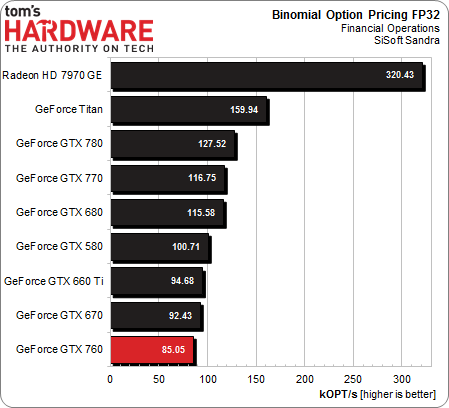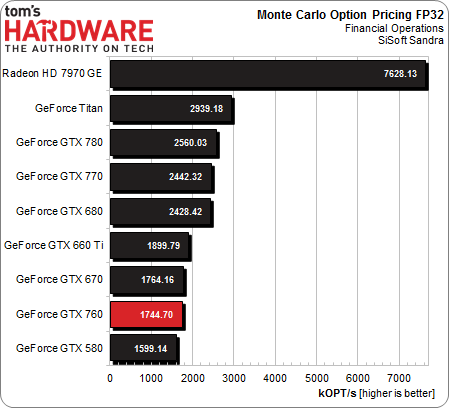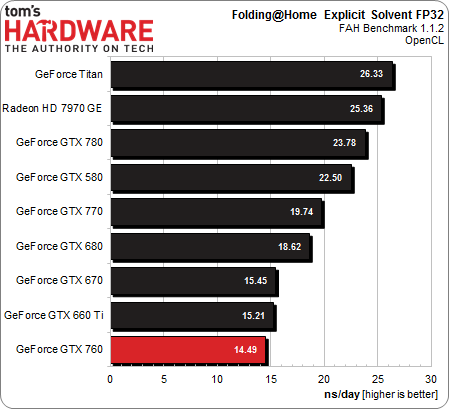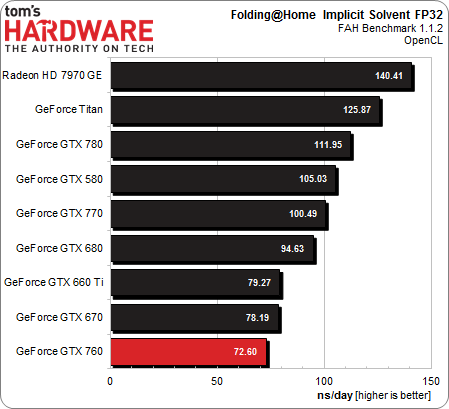GeForce GTX 760 Review: GK104 Shows Up (And Off) At $250
With its last graphics card introduction until the end of Fall, Nvidia isn't trying to impress anyone with groundbreaking performance. Rather, the company is pulling better-than GeForce GTX 660 Ti-class frame rates to a $250 price point, creating value.
OpenCL: Single-Precision
Once more, we are purposely choosing an alternate set of benchmarks that allows us to compare single- and double-precision math. Our main question today is whether more memory bandwidth and a higher core clock allows GeForce GTX 760 to outpace the GTX 660 Ti and its greater number of CUDA cores.
Financial Analysis Performance (Float/FP32)
The older GeForce GTX 660 Ti swoops in for an easy win ahead of the GeForce GTX 670 and new GTX 760. In this sort of workload, frequency and shaders count more than memory bandwidth.
Folding@Home (Float/FP32)
The Folding@Home benchmark paints a similar picture, with the GeForce GTX 760 bringing up the rear, since its wider memory interface isn’t enough to offset a lower number of shader units.
The GeForce cards come out ahead in the Folding@Home benchmark, while the Radeons remain favorites in financial analysis. Looking specifically at the GeForce GTX 760, we can see that its lower number of compute resources hurts it in OpenCL and compute-heavy scenarios. The card was able to mask this shortcoming in gaming tests thanks to higher memory bandwidth, but when it comes to crunching numbers, that’s not a bottleneck.
Get Tom's Hardware's best news and in-depth reviews, straight to your inbox.
Current page: OpenCL: Single-Precision
Prev Page CUDA Performance Next Page OpenCL: Double-Precision-
SiliconWars This doesn't look faster than the 7950 boost to me. Maybe you should check your scores and update your conclusion to reflect reality?Reply -
pauldh Reply11035777 said:This doesn't look faster than the 7950 boost to me. Maybe you should check your scores and update your conclusion to reflect reality?
Re-read the conclusion in question below. He doesn't say it is faster, he says this card will replace Don's recommendation for best $250 card and displace the 7950 Boost. ie. Don won't be recommending a $300 card that trades blows or barely beats a $250 card. If both were to end up $250, things change.
quote - "A quick reference to Best Graphics Cards For The Money: June 2013 shows that Don is currently recommending the Tahiti-based Radeon HD 7870 for $250. With almost certainty, the GeForce GTX 760 will take that honor next month, displacing the Radeon HD 7950 with Boost at $300 in the process." -
mapesdhs Chris, what is it about the GTX 580 that makes it so slow for the CUDA FluidmarkReply
test, given it does so well for the other CUDA tests, especially iRay and Blender?
Btw, I don't suppose you could include 580 SLI results for the game tests? ;)
Or do you have just the one 580?
My only gripe with the 760 is the misuse of a model number which allows one to
infer it should be quicker than older cards with 'lesser' names (660, etc.) when
infact it's often slower. I really wish NVIDIA would stop releasing products that
exhibit such enormous performance overlap. Given the evolutionary nature of
GPUs, and the time that has passed since the 600s launched, one might
reasonably expect a 760 to beat the 670 too, but it never does. To me, the
price drop is the only thing it has going for it. The endless meddling with shader
numbers, clocks, bus width, etc., creates an utter muddle of performance
response depending on the game. One really has to judge based on the
individual game rather than any general product description or spec summary.
I just hope Skyrim players with 660s don't upgrade on the assumption newer
model names mean better performance, but I expect some will.
Ian.
-
tomfreak GTX760 is an upgrade for GTX460/560 user and of all of that u didnt throw in those cards to bench with. Seriously?Reply -
Novuake Nice review as per usual Chris.Reply
Amazing performance at 250$. The 265bit memory interface does wonders for GK104.
Now I am wondering if there will even be a GTX760ti, while there is a large enough gap in the product stack, I have a feeling there is a chance there may not be a "ti" version.
Anyone know more? -
sarinaide AMD will have to release a new interim Radeon series, the existing family is not to outdated to be stretched to much longer.Reply -
horaciopz So, maybe there will be an GTX 760 ti, for about 300 bucks with the peformance of a GTX 670... Uh? nVidia really should. This remembers the gtx 400 series and 500 series... nVidia is doing it all over again.Reply




